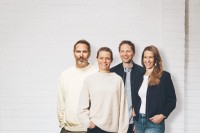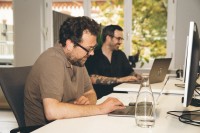With a Mandate to Push Boundaries
200 Zeichen Lorem ipsum dolor sit amet, consectetuer adipiscing elit. Aenean commodo ligula eget dolor. Aenean massa. Cum sociis natoque penatibus et magnis dis parturient montes, nascetur ridiculus mus. Donec quu.
Kim Notz
05. March 2024
One of the central arguments in a recent podcast episode is that today’s agency world looks very different from 10 or 15 years ago. That shift has also reshaped what we think of as “typical” agency careers. In fact, both the careers and the agencies themselves are becoming rarer. The landscape has fragmented—driven in large part by the explosion of marketing channels and the rise of countless specialists.
In such a complex environment, there’s a renewed need for consultants who can provide clarity and direction. Gerald Hensel and Fabian Roser are a good example of this with their boutique consultancy, superspring. The two joined me in episode #106. Together with Tobias Weißenfels, they launched the agency in 2023 with a sharp focus on strategy and creative work: Gerald as strategist, Fabian as creative lead, Tobias as consultant. All three have roots in advertising and experience at digital agencies such as Razorfish. But their view of marketing extends well beyond advertising and communications—which, in the digital age, is essential.
The neat separation between product, advertising, and sales simply no longer holds, even if some companies still cling to it. As a result, the careers of trained advertisers today are shaped by experiences that stretch beyond the traditional advertising world. It’s no longer a biographical “waterfall,” to borrow a metaphor from software development. Careers don’t just unfold inside agencies anymore; they might just as easily take shape in start-ups or other ventures. The world has become bigger and with it, the playing field for advertising and marketing. That makes guidance and orientation more valuable than ever..
No Shortage of Crazy Ideas
Marketing today is anything but short on wild ideas, channels, touchpoints, and occasions to communicate. What’s scarce, however, are independent decisions on direction and a consistent strategic backbone. Many companies struggle to provide this themselves, and agencies aren’t always the answer either.
The reason is simple: agencies are staffed with people who bring specific skills that need to be kept busy. And when all you have is a hammer, every problem starts to look like a nail. On the client side, resources are always limited, as are in-house marketing capacities. From this unprecedented abundance of options combined with ambitious goals and restricted budgets emerges a real need for guidance. That’s the gap superspring seeks to fill. Their focus is on finding smart paths to the goal, developing creative solutions, and working with agile methods more familiar from software development and start-ups than from traditional marketing.
Lorem ipsum dolor sit amet, adipiscing elit.
What superspring does remains firmly rooted in creative and strategic marketing it’s not general management consulting. Their agenda is shaped by client briefings and a focus on measurable marketing goals. Agility is part of it, but just as important are the mandate and ability to cross boundaries and bring together things others might not. It’s the familiar metaphor of the speedboat and the tankerboth have their place, but in a world that spins faster every day, maybe what we need are more speedboats.
One thing that hasn’t changed is the central role of brand work. Yes, superspring occasionally produces advertising, but their main focus as a marketing consultancy lies in strategy and concept development. Strategy is, after all, the answer to the question: how can marketing actually achieve its goals?
That means positioning brands and driving activation. Sometimes activation takes the form of a campaign but it can also go well beyond that. Their goal is to empower brands, and the people behind them, to activate in meaningful ways. That might mean communications, but it could just as well be CRM. Activation, in this sense, doesn’t stop at paid and earned media; it can also mean rethinking formats altogether.
No Shortage of Crazy Idea
Marketing certainly isn’t lacking in crazy ideas, channels, touchpoints, or occasions to communicate. What’s scarce, however, are independent decisions about direction and a genuine commitment to strategy. Many companies can’t manage that on their own—and agencies aren’t always equipped to do it either. Agencies, after all, employ specialists whose skills need to be kept in use. And when the only tool you have is a hammer, every problem starts to look like a nail.
On the corporate side, resources are always limited just like the in-house marketing teams themselves. Out of this unprecedented abundance of options, paired with ambitious goals and constrained budgets, comes a clear demand for guidance. That’s the gap superspring aims to fill. Their focus is on smart routes to the goal, creative solutions, and agile ways of working—methods more often associated with software development and start-ups than with traditional marketing.
Lorem ipsum dolor sit amet, adipiscing elit.
Superspring remains firmly rooted in creative, strategic marketing it’s not about turning into a general management consultancy. Their agenda is driven by client briefings and a focus on measurable marketing goals. To agility they add something else: the mandate, the ability, and the freedom to cross boundaries and connect things that others can’t. It’s the familiar metaphor of the speedboat versus the tanker both have their place, but in a world spinning ever faster, perhaps what we need are more speedboats.
What also remains central is the work on brands. Occasionally, superspring produces advertising, but their primary role as a marketing consultancy lies in strategy and concept development. Strategy, after all, is about answering the question: how can marketing actually achieve its goals?
That involves brand positioning and activation. Activation can mean a campaign, but it doesn’t stop there. The aim is to empower brands and the people behind them to activate in meaningful ways. Sometimes that’s communication, sometimes CRM. And activation doesn’t just mean paid and earned media; it can also mean rethinking formats entirely
Radically Collaborative
At the end of the day, it all comes down to react and that means platforms, technology, and media. To deliver on that, you need tools, people, and yes, agencies that can turn concepts into reality. As a three-person agency, superspring rarely faces the illusion that they could or should offer everything themselves. That’s precisely why collaboration is essential: with clients, with networks, with partner companies, and with other agencies. “Radically collaborative” is how they describe themselves. They enjoy bringing in outside experts and making them part of the team just as the client is part of the team from day one.
Their working methods are closer to workshops, sprints, and Scrum than to the classic agency model of briefings and polished presentations. Implementation can even happen in-house. The process is iterative, transparent, and tool-driven faster and more open than the old waterfall model, though sometimes more chaotic too. In practice, agile processes tend to be not only more flexible but also more clearly structured than conventional agency workflows. Timelines are strict, and the discipline required is high.
For creatives in particular, those structures provide freedom: with roles defined, meetings set, and decision-making processes clear, no one wastes energy on organizational headaches. Everyone can focus on the work itself. Clients and marketing leads often bring excellent ideas to the table too ideas that simply need to be refined, sharpened, and written down. This kind of direct collaboration works far better than the old back-and-forth of corrections and revisions. Clients gain more transparency, but they also have to invest more time.
The Naivety Plug-in
The consultants draw on what Fabian calls a “naivety plug-in.” They acknowledge internal structures and corporate politics, with all their taboos and limitationsbut then they switch on the plug-in and set those aside in order to find new solutions. The thinking behind it is simple: it’s easier to take a big idea, a bold concept, or a grand vision and scale it down into something realistic than it is to inflate a small vision into something larger.
Lorem ipsum dolor sit amet, adipiscing elit.
Gerald describes the right altitude as hovering just half a meter above the day-to-day whether that’s communications or social media. The focus isn’t on micromanaging execution, but on grasping contexts, steering marketing, bringing together structures and partners, and then working with them to ensure excellent delivery.
A speedboat has very different demands than a tanker. On a tanker, you might be down in the engine room, doing a clearly defined job. A speedboat, by contrast, has to stay alert sometimes even looking around to see whether a tanker might be crossing its path. What drives this way of working is curiosity: curiosity about marketing and communications, about the possibilities of technology, and about the passion for flawless execution.
But even in the engine room of a tanker, it’s hard these days to simply run processes without curiosity and genuine interest in the subject matter. Trying things out even at the risk of embarrassment or failure has become an essential part of every career. That applies whether you’re running your own agency or just starting out in the industry.
Find more here:
Kontakt





